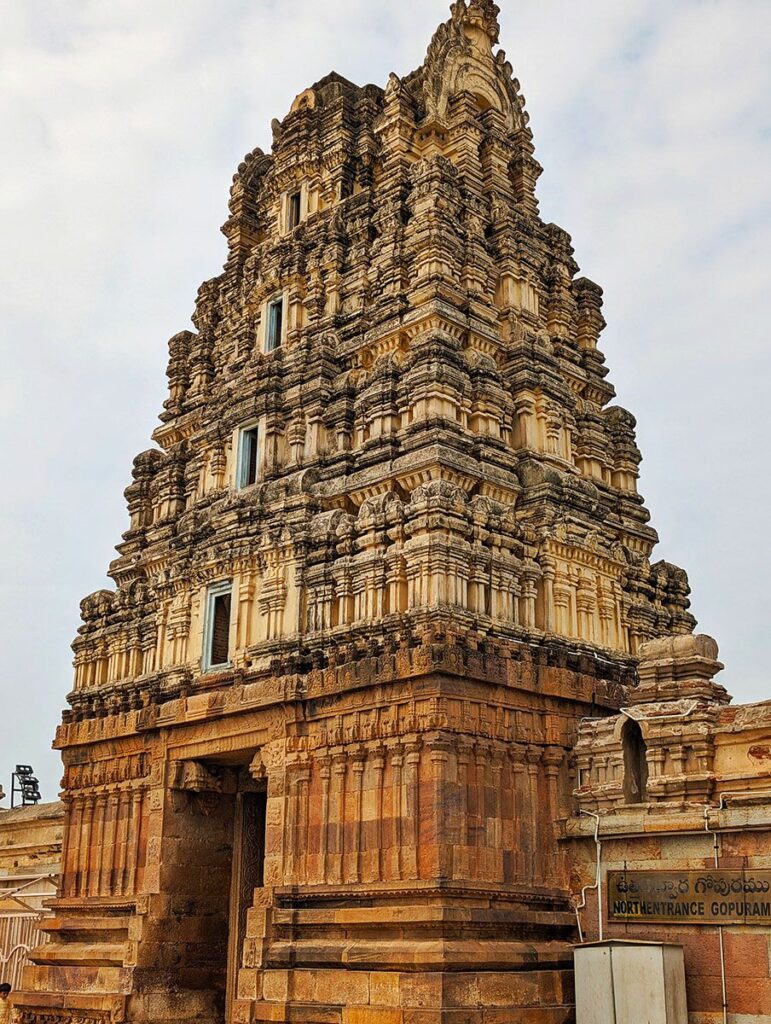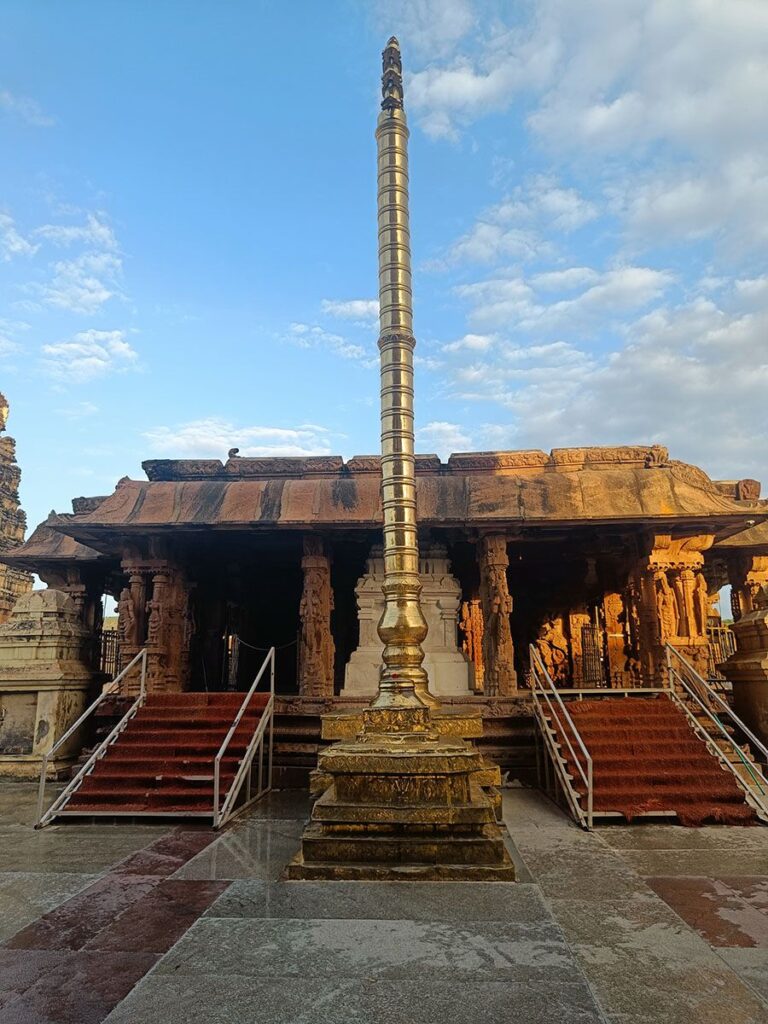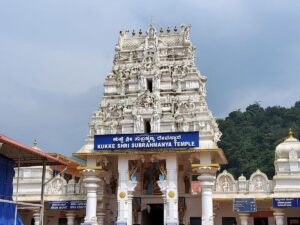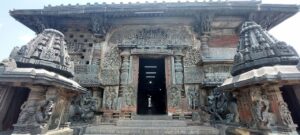Vontimitta Temple of Sri Kodanda Rama Swamy
The Vontimitta Temple, also known as the Kodandarama Temple, is a Hindu temple dedicated to the god Rama, located in Vontimitta town in Andhra Pradesh, India. It is considered the largest temple complex in the region. The temple, an example of Vijayanagara architectural style, is dated to the 16th century. It is stated to be the largest temple in the region. It is located at a distance of 25 kilometers (16 mi) from Kadapa and is close to Rajampet. The temple and its adjoining buildings are one of the centrally protected monuments of national importance.

Contents
- 1 Vontimitta Temple History:
- 2 Legend of Vontimitta Temple:
- 2.0.1 Vontimitta Temple of Sri Kodanda Rama Swamy
- 2.0.2 Arasavalli Temple | Sri Suryanarayana Swamy Temple
- 2.0.3 Powerful Annavaram Temple Sri Veera Venkata Satyanarayana Swamy
- 2.0.4 Antarvedi Lakshmi Narasimha Swamy Temple
- 2.0.5 Kapila Theertham Temple Tirupati
- 2.0.6 Srikalahasti Temple: 4th Air Vayu Lingam
- 3 Significance of Vontimitta Temple:
- 4 Myths and beliefs of Vontimitta Temple:
- 5 Architectural Style of Vontimitta Temple:
- 6 Vontimitta Temple Timing, Ritual and Festivals:
- 7 Timings:
- 8 Rituals:
- 9 Festivals:
- 9.0.1 Udupi Sri Krishna Temple: Mathura of South India
- 9.0.2 Goravanahalli Mahalakshmi Temple
- 9.0.3 Sri Kukke Subramanya Temple: Lord of Serpents
- 9.0.4 Chennakesava Temple Belur: Finest Hoysala Architecture
- 9.0.5 Shishileshwara Temple: 700 yrs old Sacred Fishes
- 9.0.6 Nayakanahatti Thipperudra Swamy Temple
- 10 Places to visit near Vontimitta Temple:
- 11 FAQ:
- 12 How to reach Vontimitta Temple:
- 13 Google Map:
Vontimitta Temple History:
Origins and Construction:
- Dating back to the 16th century, the temple was built during the reign of the Chola and Vijayanagara empires.
- The Vijayanagara architectural style is evident in the temple’s design.
Literary and Spiritual Connections:
- The temple holds special importance for Telugu literature. Bammera Potana, a revered poet, composed his magnum opus, the Maha Bhagavatham, here in praise of Lord Rama.
- Vavilakolanu Subba Rao, known as “Andhra Valmiki” for translating the Ramayana into Telugu, is also said to have worshipped at the temple.
- The saint-poet Annamacharya is believed to have visited the temple and composed devotional songs (kirtans) dedicated to Lord Rama.
Read More>> Arulmigu Sri Bannari Mariamman Temple

Legend of Vontimitta Temple:
- Vontudu and Mittudu: Local legends say they were robbers belonging to the Nishada (Boya) community who transformed into ardent devotees of Lord Rama. Their fervent desire was to build a temple for Rama.
- Building the Temple: With unwavering dedication, Vontudu and Mittudu toiled relentlessly to construct the temple. Their devotion was so immense that upon completion, they wished to become one with Lord Rama himself.
- Sacrifice and Statues: Legend has it that after the temple’s construction, Vontudu and Mittudu sacrificed themselves and turned into statues. These statues can still be seen at the temple’s entrance, forever standing guard as a testament to their devotion.
Significance of Vontimitta Temple:
- Historical Significance: Dating back to the 16th century, the temple is considered an example of Vijayanagara architecture. French traveler Jean-Baptiste Tavernier even called it one of the “grandest pagodas in the whole of India” . The temple’s architecture and art are so noteworthy that it’s designated as a centrally protected monument of national importance.
- Religious Significance: Dedicated to Lord Rama, the temple is a prominent Hindu pilgrimage site. It is said to be the largest temple in the Kadapa district. The temple is particularly known for a unique tradition – it’s the only place in India where the marriage ceremony of Lord Rama and Goddess Sita is performed at night.
- Literary Significance: The village of Vontimitta has also been a center of literary activity. Bammera Potana, who wrote the Telugu language epic, Sri Maha Bhagavatham, and Vavilakolanu Subba Rao, known for translating the Ramayana into Telugu, both lived in Vontimitta. The saint-poet Annamacharya is also said to have visited the temple.
Read More>> Swayambhu Nagaraja Temple Bengaluru

Myths and beliefs of Vontimitta Temple:
- Self-manifested idol: The main idol of Lord Vishnu in the temple is believed to be self-manifested (Swayambhu). According to legend, the idol was found buried underground and unearthed during the excavation for the temple.
- Wish-fulfilling temple: Devotees believe that praying at the Vontimitta Temple fulfills their wishes. There is a belief that offering prayers to the processional deity, Kodandarama, brings happiness and prosperity.
- Marriage with the Lord: The temple is associated with the legend of Padmavati, a local woman who is believed to have been married to Lord Vishnu. Devotees, particularly women, visit the temple seeking blessings for a happy married life.
- Connection to Tirupati: There is a belief that the Vontimitta Temple is connected to the Tirupati Tirumala Venkateswara Temple. Legends say that the idol in Vontimitta is a replica of the one in Tirupati. Devotees who are unable to visit Tirupati visit Vontimitta instead.
Read More>> Samaleswari Temple Sambalpur Odisha

Architectural Style of Vontimitta Temple:
The Vontimitta Temple follows the Dravidian architectural style, characterized by its towering Gopuram, pillared halls, and intricate sculptures. The temple complex is laid out in a traditional quadrangular plan, with a series of courtyards leading to the sanctum sanctorum.
Gopuram:
The Gopuram of the Vontimitta Temple is a prominent feature that greets visitors as they approach the sacred precincts. Rising to a considerable height, the Gopuram is adorned with intricate carvings of gods, goddesses, and celestial beings, depicting scenes from Hindu mythology. The vibrant colors and detailed craftsmanship of the Gopuram captivate the eye and evoke a sense of divine splendor.
Mandapas:
The temple complex comprises several mandapas or pillared halls, each serving a specific ceremonial or congregational purpose. The Maha Mandapa, or main hall, is where devotees gather for rituals, prayers, and religious discourses. The Kalyana Mandapa, adorned with exquisite sculptures, is where the celestial wedding of Lord Rama and Sita is celebrated with pomp and fervor during festive occasions.
Sanctum Sanctorum:
At the heart of the Vontimitta Temple lies the sanctum sanctorum, housing the sacred deity of Lord Rama. The inner sanctum is adorned with ornate decorations and illuminated by the soft glow of oil lamps, creating an atmosphere of serenity and devotion. Devotees offer prayers and perform rituals, seeking blessings for prosperity, peace, and spiritual fulfillment.
Sculptural Marvels:
One of the most striking aspects of the Vontimitta Temple is its exquisite sculptures, which adorn the walls, pillars, and ceilings of the temple complex. These sculptures depict various gods, goddesses, celestial beings, and mythical creatures, showcasing the unparalleled craftsmanship of ancient artisans. Each sculpture tells a story, capturing moments of divine grace, valor, and transcendence.
Preservation Efforts:
In recent years, concerted efforts have been made to preserve and restore the architectural heritage of the Vontimitta Temple. Conservation projects aim to safeguard the temple’s structural integrity, protect its sculptures from decay and erosion, and enhance visitor facilities. These efforts ensure that future generations can continue to marvel at the timeless beauty of this sacred edifice.
Read More>> Parasnath Temple Giridih 2 BCE Jain Temple

Vontimitta Temple Timing, Ritual and Festivals:
Timings:
Specific timings for the Vontimitta Temple might vary depending on the day of the week and any special occasions. However, here’s a general idea:
- Temple is generally open: Most temples in Andhra Pradesh follow sunrise to sunset timings. You can expect the Vontimitta Temple to be open around 6:00 AM to 6:00 PM.
- For specific timings: It’s recommended to contact the temple directly or check their official website (if they have one) for the most up-to-date timings.
Rituals:
- Talambralu: This is a special ritual during Sri Rama Navami (usually in March/April) where devotees shower rice mixed with turmeric on the idols of Lord Rama and Sita. You can participate virtually through the temple’s online booking system according to a source: [source about Vontimitta Temple Talambralu ritual].
- Other rituals: Daily pujas (prayers) are performed at the temple, but timings might vary.
Festivals:
- Sri Rama Navami: As mentioned earlier, this festival in March/April is a major celebration at Vontimitta Temple with the Talambralu ritual being a highlight.
- Vaikunta Ekadashi: This festival in December/January is dedicated to Lord Vishnu and is another prominent celebration at the temple.
- Other festivals: Throughout the year, other Hindu festivals like Ugadi (Telugu New Year), Diwali etc., might be observed at the temple with special pujas and ceremonies.
Places to visit near Vontimitta Temple:
- Sri Kodandarama Swamy Temple, Kodandarama Hill: Located atop a picturesque hilltop, the Sri Kodandarama Swamy Temple offers stunning panoramic views of the surrounding countryside. Dedicated to Lord Rama, this ancient temple is steeped in mythology and attracts devotees seeking blessings and spiritual solace.
- Belum Caves: Embark on an unforgettable underground adventure at the Belum Caves, one of the largest and longest cave systems in India. Marvel at the intricate stalactite and stalagmite formations as you explore the subterranean chambers and passages that date back millions of years.
- Gandikota Fort: Often referred to as the “Grand Canyon of India,” Gandikota Fort is a breathtaking fortress perched on the banks of the Penna River. Explore the ancient ruins, towering ramparts, and majestic gateways of this historic stronghold, which offers commanding views of the rugged landscape below.
- Ahobilam: Embark on a spiritual pilgrimage to Ahobilam, a sacred Vaishnavite shrine nestled amidst the lush Nallamala Hills. This revered pilgrimage site is renowned for its nine Narasimha temples, each dedicated to Lord Narasimha in various forms, and offers opportunities for trekking and wildlife spotting in the surrounding forests.
- Tadipatri: Discover the architectural splendor of Tadipatri, home to a treasure trove of ancient temples and monuments. Admire the exquisite carvings and intricate sculptures at the Bugga Ramalingeswara Temple, Chintala Venkataramana Swamy Temple, and other architectural marvels that showcase the rich heritage of the region.
- Rollapadu Bird Sanctuary: Nature enthusiasts will delight in a visit to the Rollapadu Bird Sanctuary, a haven for avian biodiversity located near the town of Nandikotkur. Embark on a bird-watching excursion to spot a diverse array of migratory and resident bird species, including flamingos, pelicans, herons, and eagles.
- Gundla Brahmeswaram Wildlife Sanctuary: Immerse yourself in the pristine wilderness of the Gundla Brahmeswaram Wildlife Sanctuary, home to a wide variety of flora and fauna. Explore the lush forests, tranquil water bodies, and scenic hiking trails, and keep an eye out for indigenous wildlife such as deer, wild boar, sloth bears, and leopards.
- Kadapa: Discover the cultural heritage of Kadapa, a bustling city steeped in history and tradition. Explore ancient temples, including the Sri Venkateswara Temple and Ameen Peer Dargah, visit historical sites such as the Gandikota Fort and Sri Venkateswara Wildlife Sanctuary, and sample local cuisine at bustling markets and eateries.
FAQ:
General Information:
- What is the main deity of the temple? The main deity of the temple is Lord Vishnu, also worshipped as Kodandarama (Rama holding a bow).
- When was the temple built? The temple is estimated to be built in the 16th century, during the Vijayanagara Empire rule.
- What is the architectural style of the temple? The temple follows the Vijayanagara architectural style.
- Is there an entry fee for the temple? No, there is no entry fee for the temple. However, specific pujas and offerings may have associated costs.
Visiting the Temple:
- What are the timings of the temple? The temple timings are generally between 6 AM to 9 PM. It’s recommended to check for specific timings during festivals or puja ceremonies.
- How to reach the temple? The temple is located in Vontimitta town, Andhra Pradesh, about 25 kilometers from Kadapa. You can find information on reaching Kadapa by road, rail, or air, and then take local transport to Vontimitta.
- Is there accommodation available near the temple? There are no hotels within the temple itself. However, guesthouses and budget hotels are available in nearby towns like Rajampeta. Planning your accommodation in advance, especially during festivals, is recommended.
- What are the facilities available for pilgrims? Basic amenities like food stalls, water, and medical aid are usually available near the temple. It’s always a good idea to carry essentials like water and hats, especially during peak seasons.
Special Events:
- What is Sita Rama Kalyanam? Sita Rama Kalyanam is the ceremonial wedding of Lord Rama and Goddess Sita. This is a popular event at the temple, attracting large crowds. There may be ticketed seating arrangements for the ceremony.
- When is Sita Rama Kalyanam celebrated? The exact dates of Sita Rama Kalyanam can vary. It’s best to consult the temple website or local sources for upcoming dates.
Other:
- Can non-Hindus visit the temple? Yes, people of all faiths are welcome to visit the temple, provided they dress modestly and respect the temple customs and rituals.
- Is photography allowed inside the temple? Photography policies may vary depending on the temple administration. It’s best to check with the temple authorities before taking photos.
How to reach Vontimitta Temple:
By Air:
The nearest airport to Vontimitta is the Tirupati Airport (also known as Renigunta Airport), located approximately 115 kilometers away. From Tirupati Airport, you can hire a taxi or take a bus to reach Vontimitta. The journey by road takes around 2-3 hours, depending on traffic conditions.
By Train:
The closest railway station to Vontimitta is the Kadapa Railway Station, situated around 32 kilometers away. Kadapa Railway Station is well-connected to major cities like Hyderabad, Chennai, Bangalore, and Vijayawada. From Kadapa Railway Station, you can hire a taxi or take a local bus to reach Vontimitta. The journey by road typically takes around 45 minutes to 1 hour.
By Road:
Vontimitta is well-connected by road, and there are several options for reaching the temple by bus or private vehicle:
- From Kadapa: Vontimitta is located approximately 32 kilometers from Kadapa. You can take a bus or hire a taxi from Kadapa to reach the temple. The journey by road takes around 45 minutes to 1 hour.
- From Tirupati: Vontimitta is situated approximately 130 kilometers from Tirupati. You can take a bus or hire a taxi from Tirupati to reach the temple. The journey by road takes around 3 hours.
- From Bangalore: Vontimitta is located approximately 300 kilometers from Bangalore. You can drive or take a bus from Bangalore to reach the temple. The journey by road takes around 6-7 hours, depending on traffic conditions.
- From Hyderabad: Vontimitta is situated approximately 330 kilometers from Hyderabad. You can drive or take a bus from Hyderabad to reach the temple. The journey by road takes around 7-8 hours.
Local Transportation:
Once you reach Vontimitta, you can easily explore the temple and its surroundings on foot. However, if you prefer, you can also hire a local auto-rickshaw or taxi for sightseeing purposes.












